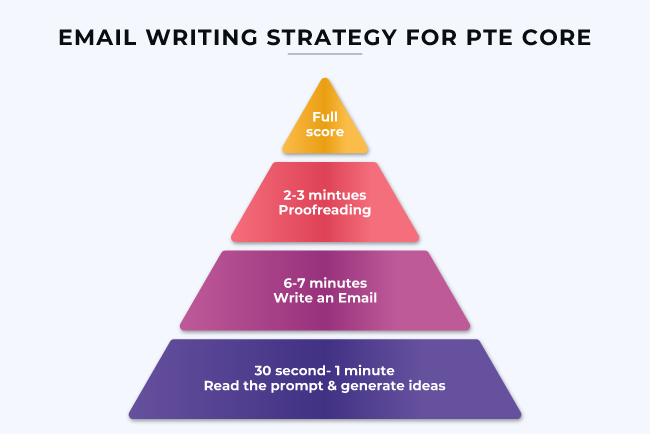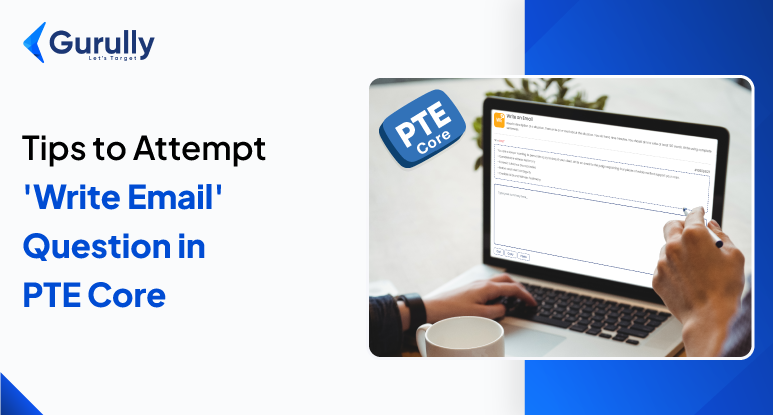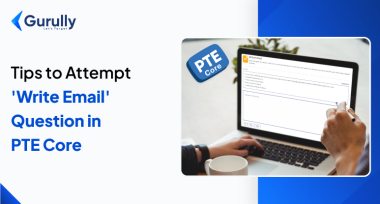The PTE Core is a growing choice for demonstrating your English language skills. If you plan to take the test, staying up-to-date on PTE Core Email Writing Questions is crucial for success.
The PTE Core exam throws a variety of writing tasks your way, and composing an effective email is crucial. But fear not, aspiring PTE test takers! All you require is proper strategic tips and PTE Core practice. It can feel daunting with a tight time limit and specific criteria. This guide equips you with the knowledge and strategies to excel in the PTE Core Email Writing Questions.
What is “Write Email”
First, let’s break down what is PTE Core writing email task. You’ll be presented with a prompt outlining a specific situation. Based on this prompt, you’ll need to write an email of approximately 100 words within a limited timeframe of 9 minutes.
The prompt will usually include details about:
- Recipient: To whom are you addressing the email (e.g., colleague, manager, neighbor)?
- Purpose: What’s the reason for writing the email (e.g., request information, express concern, offer suggestions)?
- Required Details: Specific information you need to convey in the email (e.g., dates, deadlines, suggestions).
| Exam Component | Details |
| Total Time Task | 9 Minutes |
| Word Limit | 50-120 |
| Number of Questions | 1-2 |
| Type of Email | Formal, Informal & Semiformal |
| Scoring Criteria | Content, email conventions, form, organization, grammar, vocabulary |
How to Crack “PTE Core Email Writing Questions” Question Type
Understanding the Write Email Task
Second, let’s learn how to attempt the PTE Core writing email task. You’ll be presented with a prompt outlining a specific situation. Based on this prompt, you’ll need to write an email of approximately 100 words within a limited timeframe of 9 minutes.
The prompt will usually include details about:
- Recipient: To whom are you addressing the email (e.g., colleague, manager, neighbor)?
- Purpose: What’s the reason for writing the email (e.g., request information, express concern, offer suggestions)?
- Required Details: Specific information you need to convey in the email (e.g., dates, deadlines, suggestions).
Try to Write Effective Email :
Now that you understand the PTE Core writing email format, let’s dive into how to write a high-impact scoring email.
- Time is precious in the PTE exam, so effective planning goes a long way. Here’s how to approach the pre-writing stage:
- Read the prompt carefully: Don’t skim through it. Identify all the crucial details: recipient, purpose, and required information.
- Organize your thoughts: Briefly jot down the key points you must address in the email.
- Structure your email mentally: Decide on a clear opening, body, and closing structure.
Write With Clarity & To-the-point
Once you have a plan, it’s time to translate your thoughts into clear and concise email language.
- Formal vs. Informal: The prompt will usually indicate the formality level of the email. Maintain a professional tone while avoiding stiff or overly formal language in semi-formal situations.
- Sentence Structure: Use clear and concise sentences. Aim for a mix of sentence lengths to avoid monotony.
- Grammar and Vocabulary: Ensure proper grammar and use an appropriate level of vocabulary that demonstrates your language proficiency.
Want To Know More About PTE Core : PTE Core Test Format 2024
Craft Correct Email Structure:
Let’s dissect the essential elements of a strong email structure in PTE Core:
- Opening (Greeting): Depending on the formality level, use a professional salutation like “Dear [Recipient Name]” or “Hello [Recipient Name].”
- Body Paragraph(s): This is the heart of your email. Clearly state the purpose of your email and provide the required information. Use transitions to connect your ideas smoothly.
- Closing: Conclude the email with a closing phrase like “Sincerely,” “Best Regards,” or “Thanks,” followed by your name (optional).
| Email Conventions | Examples |
| Formal Greetings | Dear (name), Good morning/afternoon (name), Respected (name), Greetings (name), To whom it may concern, |
| Informal Greetings | Hi (name), Hello (name), Hello team |
| Formal Signoffs | Warm regards, Sincerely, Best regards, Yours respectfully, Kind regards, Thanks, |
| Informal Signoffs | Thanks, Warmly, Regards, See you, Best wishes, |

Example 1:
You are a web developer at a software company and need to request a leave of absence to attend a web development conference. How would you frame an email to your manager, Ms. Lee?
Answer:
Dear Ms. Lee,
I’d like to request leave to attend the [Conference Name] on web development (from [Start Date] to [End Date]). It covers [mention key areas], directly benefiting projects like [project names].
By attending, I can learn new technologies and best practices through networking with experts. I’ve completed [key tasks] and will ensure everything is documented. I’ll be available remotely for emergencies and share conference insights upon return.
Thank you for your consideration.
Sincerely, [Your Name]
Example 2:
You ordered a laptop online, but when it was delivered, it was damaged. Write an email to the customer service team of the online store, explaining the issue and requesting a replacement or refund.
Answer:
Subject: Request for Replacement or Refund – Damaged Laptop Received
Dear Customer Service,
I recently purchased a laptop from your website (Order #45982) and received it yesterday. Unfortunately, upon unboxing, I noticed that the screen was cracked and the keyboard was not functioning properly.
I request either a full refund or a replacement unit at your earliest convenience. I have attached photos of the damage for your reference. Kindly advise on the next steps.
Looking forward to your prompt response.
Sincerely,
Alex Thompson
Example 3:
Your apartment building’s elevator has not been working for several days. Write an email to the building manager to report the issue and ask when it will be fixed.
Answer:
Subject: Elevator Out of Service – Request for Update
Dear Mr. Patel,
I hope you are well. I’m writing to inform you that the elevator in Block B has not been working since Monday morning. Many residents, including the elderly and parents with young children, are facing serious difficulties as a result.
I understand that repairs take time, but we would really appreciate an update on the expected timeline for restoration. If a temporary solution is possible, please consider that as well.
Thank you for your attention to this matter. We look forward to a prompt resolution.
Best regards,
Neha Verma
Example 4:
You applied for a job two weeks ago but haven’t received a response. Write an email to the HR manager asking for an update.
Answer:
Subject: Follow-up on Job Application – Marketing Executive Position
Dear Ms. Roy,
I hope this message finds you well. I applied for the Marketing Executive position at your company on April 15, 2025, and submitted all the required documents through your career portal.
I wanted to follow up on the status of my application and express my continued interest in the role. With my background in digital marketing and two years of relevant experience, I believe I would be a valuable addition to your team.
I would appreciate any updates regarding the recruitment process. Please let me know if any further information is required from my side.
Thank you for your time and consideration.
Sincerely,
Ritika Sharma
Example 5:
You recently attended a workshop and want to request a certificate of participation. Write an email to the event organizer.
Answer:
Subject: Request for Certificate of Participation – Data Analytics Workshop
Dear Sir/Madam,
I hope you are doing well. I attended your online Data Analytics Workshop held on April 22, 2025, and found it extremely informative and well-organized.
I am writing to kindly request a certificate of participation, which was mentioned during registration. I would appreciate it if you could email the certificate to me at your earliest convenience. My full name is Sneha Mehra, and I attended all sessions of the workshop.
Please let me know if any additional details or identification are required for verification purposes.
Thank you once again for conducting such a valuable learning session.
Best regards,
Sneha Mehra
Example 6:
You found a billing error on your electricity bill. Write an email to the electricity company to report the issue and request correction.
Answer:
Subject: Billing Error in April Electricity Bill – Account #189237
Dear Customer Service,
I am writing to report a discrepancy in my electricity bill for the month of April 2025. My account number is 189237, and the bill dated April 28 reflects an unusually high charge of ₹4,800, which does not match my typical monthly usage.
Kindly review the meter readings and reissue a corrected bill if an error is found. I have attached a photo of the current meter reading along with previous bill copies for your reference.
Please confirm receipt of this email and advise on the resolution process. I would appreciate it if this matter could be resolved promptly to avoid any service disruption.
Sincerely,
Rajeev Kumar
Example 7:
You want to book a conference room for an official meeting. Write an email to the facilities manager requesting the booking.
Answer:
Subject: Request to Book Conference Room – May 6, 2025
Dear Mr. Desai,
I hope you are well. I would like to request the booking of Conference Room 2 on May 6, 2025, from 10:00 AM to 1:00 PM for a departmental strategy meeting.
We expect around 12 participants and would require a projector, a whiteboard, and seating arrangements in boardroom style. Please confirm if the room is available at the specified time and whether the mentioned equipment can be arranged.
If there are any formal procedures or forms to complete, kindly share the details with me. Your assistance in organizing this will be greatly appreciated.
Looking forward to your confirmation.
Kind regards,
Anjali Verma
Operations Team
Example 8:
You are unable to attend an important training session at your office due to a personal emergency. Write an email to your supervisor requesting rescheduling.
Answer:
Subject: Request to Reschedule Training Session – Personal Emergency
Dear Mr. Khan,
I hope you are well. I was scheduled to attend the compliance training session on May 3, 2025. Unfortunately, due to an urgent personal matter, I will be unable to attend the session as planned.
I sincerely apologize for the inconvenience and kindly request if it would be possible to reschedule my session or join an alternate batch, if available. I understand the importance of this training and assure you that I will complete it at the earliest opportunity.
Please let me know the next available date or any steps I should take for rescheduling.
Thank you for your understanding and support.
Sincerely,
Manish Tiwari
Example 9:
You purchased a product online, but you received the wrong item. Write an email to the seller explaining the issue and requesting the correct product.
Answer:
Subject: Received Incorrect Item – Order #XH47829
Dear Customer Support,
I recently placed an order on your website for a wireless Bluetooth speaker (Order #XH47829), which was delivered to me on May 1, 2025. However, I received a set of wired headphones instead of the item I ordered.
I request that you kindly arrange for the correct product to be shipped to me as soon as possible. I have attached a photo of the item I received for your reference. Please also advise on the return process for the incorrect item.
I would appreciate a prompt resolution, as the speaker was intended for an upcoming event. Kindly confirm receipt of this message and let me know how to proceed.
Thank you for your assistance.
Sincerely,
Prakash Menon
Example 10:
Your office air conditioning system is not functioning properly. Write an email to the building maintenance team requesting urgent repairs.
Answer:
Subject: Request for Urgent Repair – Office Air Conditioning Unit
Dear Maintenance Team,
I hope this message finds you well. I am writing to inform you that the air conditioning system in our office (Room 3B, Second Floor) has not been working properly for the last two days. It is blowing warm air and making unusual noises.
This has caused significant discomfort to the staff, especially during afternoon hours when temperatures are high. I kindly request that a technician be sent to inspect and repair the unit at the earliest possible time.
Please confirm when the repair team will be available so we can ensure access to the room. We appreciate your prompt attention to this matter, as it is affecting our productivity.
Looking forward to your swift response.
Kind regards,
Ritika Singh
Admin Executive
How Scoring Is Done For “PTE Core Writing Email”
Two things are mainly checked:
- What you say (Content): This is the most important part. Did you answer the prompt correctly and give all the necessary information? Irrelevant answers or having no answer at all get zero points here.
- How you say it (Form): This is like following email writing rules. Did you use a proper greeting, structure your message clearly, and use good grammar and spelling?
Further Breakdown:
- They might not even check the “form” part if your email is too short or long.
- If you do meet the length requirement, they’ll check things like:
- Did you use a proper salutation (Dear Mr./Ms. Last Name)?
- Is your email organized and easy to follow?
- Do you use a variety of words and avoid mistakes?
In addition to knowing how to crack PTE Core writing email, you must practice carefully. Gurully offers you an online practice platform to practice this question type. We also provide you with a full-length mock test to prepare PTE Core. You can also customize the plan according to your needs.
Conclusion:
We’ve shown you how to understand the prompts, write clear and strong content, and structure your emails in a way that scores high. Now, it’s time to put those skills into action! Set a timer for 9 minutes (just like the real test) and practice writing emails based on sample prompts you can find online.
The more you practice under timed conditions, the more comfortable and confident you’ll feel on test day. Remember, even small mistakes can add up, so focus on getting all the key points from the prompt into your email while keeping your grammar and vocabulary accurate. With hard work, the right approach, and plenty of practice, you’ll write your way to a fantastic PTE score!
Also Read:
- PTE Summarize Written Text Template & Predictive Q&A
- PTE Write From Dictation Tips & Tricks to Score Higher
- PTE Essay Writing Template – Ace Your PTE Academic Exam!!
- PTE Reading Fill in the Blanks: Tips, Templates & Examples for Success
Useful Pages for PTE Core Test Takers







